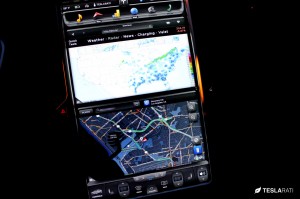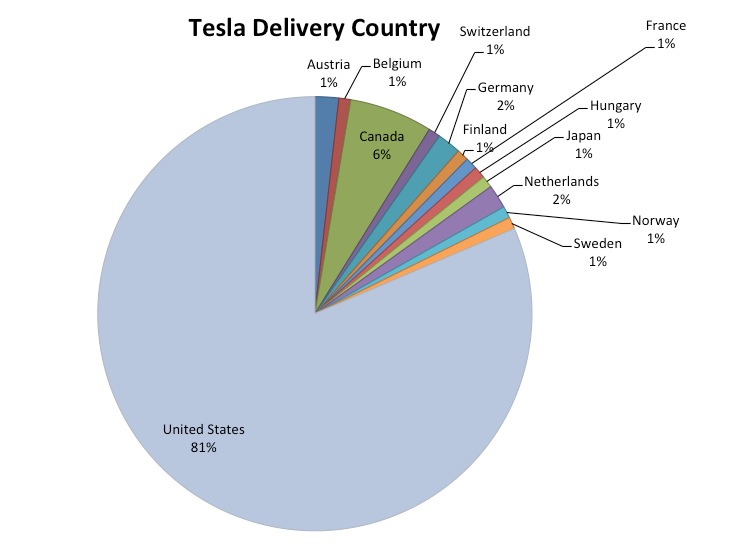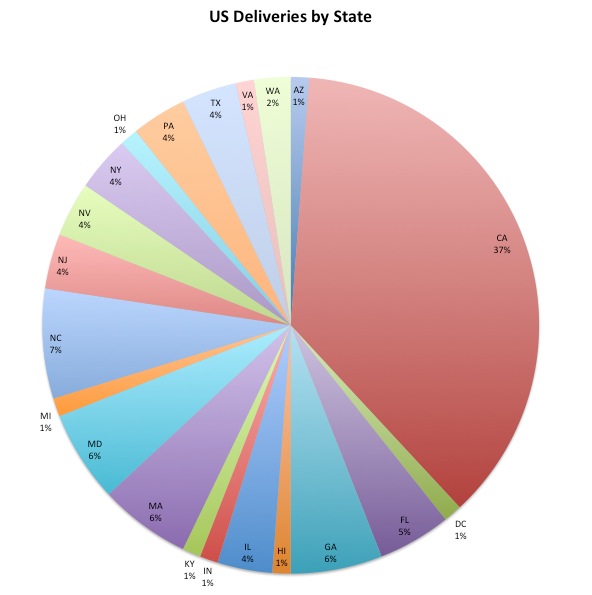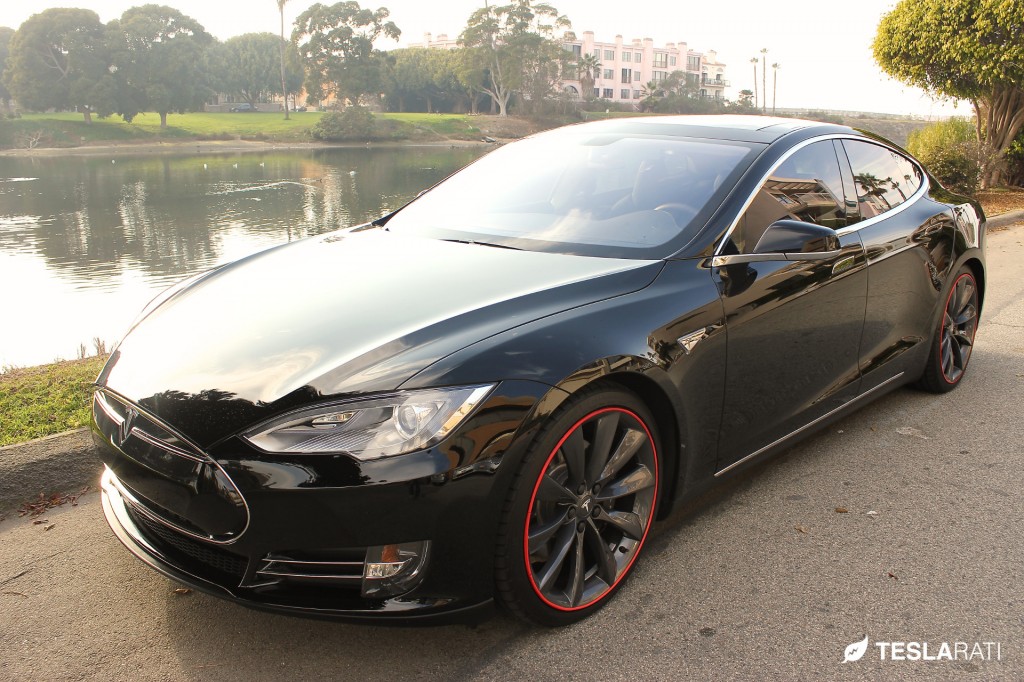News
Revealing the Most Popular Tesla Model S Configurations

New Tesla buyers are known to solicit feedback from members of the forum community on whether their proposed configuration is the right choice. I find this rather amusing considering there’s really no right choice and it’s purely subjective. What would be more valuable, and more interesting to say the least, is to see what configuration Tesla Model S owners are likely to walk away with.
Luckily some folks from the TeslaMotorsClub have already compiled a google doc that may give us an idea of what Model S options people are actually ordering. Let it be known that the results are based on a very small sample size that represents only a small fraction of the actual sales figures.
Tesla Model S Delivery by Country
It’s no surprise that 93% of orders are being delivered to owners within the US with the rest coming from Canada and Europe.
Within the US, California leads the pack at 37% while North Carolina comes ranks in second place followed by Massachusetts, Maryland, and Georgia.
Model S Battery Choice
Most Popular Color
 Black leads the pack at 23% of Model S owners choosing that as their color of choice with blue and grey a tie for second at 18%.
Black leads the pack at 23% of Model S owners choosing that as their color of choice with blue and grey a tie for second at 18%.
76% of buyers are upgrading to leather. The choice of color in the leather is pretty evenly split between all 3 color offerings. "Piano Black" stands out as the most popular interior trim with 51% of buyers selecting that offering. The remaining trim options are split evenly.
Only a mere 2% of buyers select Tesla's paint armor option.
Another interesting data point is that 39% of P85 customers select the red brake calliper option despite it being a free upgrade with the P85. The spoiler ranks higher in popularity with 52% of P85 customers selecting it.
Roof Selection
The Tesla panoramic roof is one of the coolest selling points of the car and as expected 69% of buyers choose it when configuring their Model S. If you don't select the panoramic roof you have the option to choose a roof that's painted in the color of the body or in black. 28% of buyers chose the body colored roof.
Technology Package
 Likely to no ones surprise 85% of buyers chose the technology package which includes turn by turn routing, powered lift gate and many other fantastic features right on the 17" touchscreen. Without the Tech Package, some features of the vehicle are inaccessible. 80% of the people that picked the technology package opted for parking sensors but only 37% of them choose fog lights.
Likely to no ones surprise 85% of buyers chose the technology package which includes turn by turn routing, powered lift gate and many other fantastic features right on the 17" touchscreen. Without the Tech Package, some features of the vehicle are inaccessible. 80% of the people that picked the technology package opted for parking sensors but only 37% of them choose fog lights.
The Subzero weather package is not too popular at 26% but may grow over time as Tesla gains sales strength in colder regions such as the Northeast US and in Europe. I was surprised that 41% of buyers are choosing the premium sound option as it is a very pricy option that also requires a subscription for XM use.
Also see: The Sound in the Tesla Model S
45% of people who opted for the technology package also choose to add the smart air suspension
I thought was crazy when I added the premium interior lighting package for an extra $1,000, but 81% of buyers are doing the same thing. That makes me feel a lot better about my decision!
Model S owners also seemed to really like the parcel shelf with 81% of buyers choosing it.
Single vs Dual Charger
Only 37% of buyers are choosing dual chargers which I personally believe is a necessity. Hopefully with better education buyers will opt for the dual charger option and save themselves from incurring a costly post-upgrade charge.
Also see: Every New Tesla Owner’s Dilemma: Dual Chargers vs High Power Wall Connector (HPWC)
Tesla Model S by the Numbers
Summarizing the most popular options you'd end up buying a black non-performance 85 kWh Tesla with panoramic sunroof and Piano Black decor, tech package, parking sensors and the parcel shelf. This configuration goes for approximately $83,070 after Federal and state incentives.
Ultimately the options you pick for your Tesla Model S is your choice and owners will tell you that you can't buy a bad Tesla.

Elon Musk
Elon Musk and Tesla AI Director share insights after empty driver seat Robotaxi rides
The executives’ unoccupied tests hint at the rapid progress of Tesla’s unsupervised Robotaxi efforts.

Tesla CEO Elon Musk and AI Director Ashok Elluswamy celebrated Christmas Eve by sharing personal experiences with Robotaxi vehicles that had no safety monitor or occupant in the driver’s seat. Musk described the system’s “perfect driving” around Austin, while Elluswamy posted video from the back seat, calling it “an amazing experience.”
The executives’ unoccupied tests hint at the rapid progress of Tesla’s unsupervised Robotaxi efforts.
Elon and Ashok’s firsthand Robotaxi insights
Prior to Musk and the Tesla AI Director’s posts, sightings of unmanned Teslas navigating public roads were widely shared on social media. One such vehicle was spotted in Austin, Texas, which Elon Musk acknowleged by stating that “Testing is underway with no occupants in the car.”
Based on his Christmas Eve post, Musk seemed to have tested an unmanned Tesla himself. “A Tesla with no safety monitor in the car and me sitting in the passenger seat took me all around Austin on Sunday with perfect driving,” Musk wrote in his post.
Elluswamy responded with a 2-minute video showing himself in the rear of an unmanned Tesla. The video featured the vehicle’s empty front seats, as well as its smooth handling through real-world traffic. He captioned his video with the words, “It’s an amazing experience!”
Towards Unsupervised operations
During an xAI Hackathon earlier this month, Elon Musk mentioned that Tesla owed be removing Safety Monitors from its Robotaxis in Austin in just three weeks. “Unsupervised is pretty much solved at this point. So there will be Tesla Robotaxis operating in Austin with no one in them. Not even anyone in the passenger seat in about three weeks,” he said. Musk echoed similar estimates at the 2025 Annual Shareholder Meeting and the Q3 2025 earnings call.
Considering the insights that were posted Musk and Elluswamy, it does appear that Tesla is working hard towards operating its Robotaxis with no safety monitors. This is quite impressive considering that the service was launched just earlier this year.
Elon Musk
Starlink passes 9 million active customers just weeks after hitting 8 million
The milestone highlights the accelerating growth of Starlink, which has now been adding over 20,000 new users per day.

SpaceX’s Starlink satellite internet service has continued its rapid global expansion, surpassing 9 million active customers just weeks after crossing the 8 million mark.
The milestone highlights the accelerating growth of Starlink, which has now been adding over 20,000 new users per day.
9 million customers
In a post on X, SpaceX stated that Starlink now serves over 9 million active users across 155 countries, territories, and markets. The company reached 8 million customers in early November, meaning it added roughly 1 million subscribers in under seven weeks, or about 21,275 new users on average per day.
“Starlink is connecting more than 9M active customers with high-speed internet across 155 countries, territories, and many other markets,” Starlink wrote in a post on its official X account. SpaceX President Gwynne Shotwell also celebrated the milestone on X. “A huge thank you to all of our customers and congrats to the Starlink team for such an incredible product,” she wrote.
That growth rate reflects both rising demand for broadband in underserved regions and Starlink’s expanding satellite constellation, which now includes more than 9,000 low-Earth-orbit satellites designed to deliver high-speed, low-latency internet worldwide.
Starlink’s momentum
Starlink’s momentum has been building up. SpaceX reported 4.6 million Starlink customers in December 2024, followed by 7 million by August 2025, and 8 million customers in November. Independent data also suggests Starlink usage is rising sharply, with Cloudflare reporting that global web traffic from Starlink users more than doubled in 2025, as noted in an Insider report.
Starlink’s momentum is increasingly tied to SpaceX’s broader financial outlook. Elon Musk has said the satellite network is “by far” the company’s largest revenue driver, and reports suggest SpaceX may be positioning itself for an initial public offering as soon as next year, with valuations estimated as high as $1.5 trillion. Musk has also suggested in the past that Starlink could have its own IPO in the future.
News
NVIDIA Director of Robotics: Tesla FSD v14 is the first AI to pass the “Physical Turing Test”
After testing FSD v14, Fan stated that his experience with FSD felt magical at first, but it soon started to feel like a routine.

NVIDIA Director of Robotics Jim Fan has praised Tesla’s Full Self-Driving (Supervised) v14 as the first AI to pass what he described as a “Physical Turing Test.”
After testing FSD v14, Fan stated that his experience with FSD felt magical at first, but it soon started to feel like a routine. And just like smartphones today, removing it now would “actively hurt.”
Jim Fan’s hands-on FSD v14 impressions
Fan, a leading researcher in embodied AI who is currently solving Physical AI at NVIDIA and spearheading the company’s Project GR00T initiative, noted that he actually was late to the Tesla game. He was, however, one of the first to try out FSD v14.
“I was very late to own a Tesla but among the earliest to try out FSD v14. It’s perhaps the first time I experience an AI that passes the Physical Turing Test: after a long day at work, you press a button, lay back, and couldn’t tell if a neural net or a human drove you home,” Fan wrote in a post on X.
Fan added: “Despite knowing exactly how robot learning works, I still find it magical watching the steering wheel turn by itself. First it feels surreal, next it becomes routine. Then, like the smartphone, taking it away actively hurts. This is how humanity gets rewired and glued to god-like technologies.”
The Physical Turing Test
The original Turing Test was conceived by Alan Turing in 1950, and it was aimed at determining if a machine could exhibit behavior that is equivalent to or indistinguishable from a human. By focusing on text-based conversations, the original Turing Test set a high bar for natural language processing and machine learning.
This test has been passed by today’s large language models. However, the capability to converse in a humanlike manner is a completely different challenge from performing real-world problem-solving or physical interactions. Thus, Fan introduced the Physical Turing Test, which challenges AI systems to demonstrate intelligence through physical actions.
Based on Fan’s comments, Tesla has demonstrated these intelligent physical actions with FSD v14. Elon Musk agreed with the NVIDIA executive, stating in a post on X that with FSD v14, “you can sense the sentience maturing.” Musk also praised Tesla AI, calling it the best “real-world AI” today.











